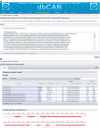dbCAN: a web resource for automated carbohydrate-active enzyme annotation
- PMID: 22645317
- PMCID: PMC3394287
- DOI: 10.1093/nar/gks479
dbCAN: a web resource for automated carbohydrate-active enzyme annotation
Abstract
Carbohydrate-active enzymes (CAZymes) are very important to the biotech industry, particularly the emerging biofuel industry because CAZymes are responsible for the synthesis, degradation and modification of all the carbohydrates on Earth. We have developed a web resource, dbCAN (http://csbl.bmb.uga.edu/dbCAN/annotate.php), to provide a capability for automated CAZyme signature domain-based annotation for any given protein data set (e.g. proteins from a newly sequenced genome) submitted to our server. To accomplish this, we have explicitly defined a signature domain for every CAZyme family, derived based on the CDD (conserved domain database) search and literature curation. We have also constructed a hidden Markov model to represent the signature domain of each CAZyme family. These CAZyme family-specific HMMs are our key contribution and the foundation for the automated CAZyme annotation.
Figures


Similar articles
-
dbCAN-seq: a database of carbohydrate-active enzyme (CAZyme) sequence and annotation.Nucleic Acids Res. 2018 Jan 4;46(D1):D516-D521. doi: 10.1093/nar/gkx894. Nucleic Acids Res. 2018. PMID: 30053267 Free PMC article.
-
dbCAN2: a meta server for automated carbohydrate-active enzyme annotation.Nucleic Acids Res. 2018 Jul 2;46(W1):W95-W101. doi: 10.1093/nar/gky418. Nucleic Acids Res. 2018. PMID: 29771380 Free PMC article.
-
dbCAN3: automated carbohydrate-active enzyme and substrate annotation.Nucleic Acids Res. 2023 Jul 5;51(W1):W115-W121. doi: 10.1093/nar/gkad328. Nucleic Acids Res. 2023. PMID: 37125649 Free PMC article.
-
The continuing expansion of CAZymes and their families.Curr Opin Chem Biol. 2019 Dec;53:82-87. doi: 10.1016/j.cbpa.2019.08.004. Epub 2019 Sep 21. Curr Opin Chem Biol. 2019. PMID: 31550558 Review.
-
Carbohydrate-Active enZyme (CAZyme) enabled glycoengineering for a sweeter future.Curr Opin Biotechnol. 2020 Dec;66:283-291. doi: 10.1016/j.copbio.2020.09.006. Epub 2020 Nov 8. Curr Opin Biotechnol. 2020. PMID: 33176229 Review.
Cited by
-
Digital Microbe: a genome-informed data integration framework for team science on emerging model organisms.Sci Data. 2024 Sep 4;11(1):967. doi: 10.1038/s41597-024-03778-z. Sci Data. 2024. PMID: 39232008 Free PMC article.
-
De novo genome assembly and annotation of rice sheath rot fungus Sarocladium oryzae reveals genes involved in Helvolic acid and Cerulenin biosynthesis pathways.BMC Genomics. 2016 Mar 31;17:271. doi: 10.1186/s12864-016-2599-0. BMC Genomics. 2016. PMID: 27036298 Free PMC article.
-
Penicillium arizonense, a new, genome sequenced fungal species, reveals a high chemical diversity in secreted metabolites.Sci Rep. 2016 Oct 14;6:35112. doi: 10.1038/srep35112. Sci Rep. 2016. PMID: 27739446 Free PMC article.
-
Complete genome sequence analysis of Pestalotiopsis microspora, a fungal pathogen causing kiwifruit postharvest rots.BMC Genomics. 2024 Sep 6;25(1):839. doi: 10.1186/s12864-024-10751-y. BMC Genomics. 2024. PMID: 39243028 Free PMC article.
-
Whole-Genome Sequencing and Bioinformatics Analysis of Apiotrichum mycotoxinivorans: Predicting Putative Zearalenone-Degradation Enzymes.Front Microbiol. 2020 Aug 3;11:1866. doi: 10.3389/fmicb.2020.01866. eCollection 2020. Front Microbiol. 2020. PMID: 32849454 Free PMC article.
References
-
- Hess M, Sczyrba A, Egan R, Kim TW, Chokhawala H, Schroth G, Luo S, Clark DS, Chen F, Zhang T, et al. Metagenomic discovery of biomass-degrading genes and genomes from cow rumen. Science. 2011;331:463–467. - PubMed
Publication types
MeSH terms
Substances
LinkOut - more resources
Full Text Sources
Other Literature Sources

